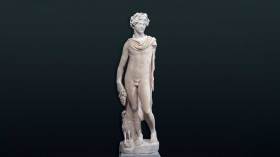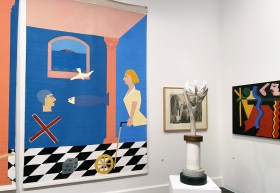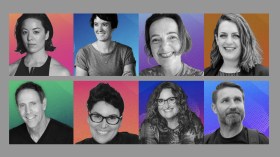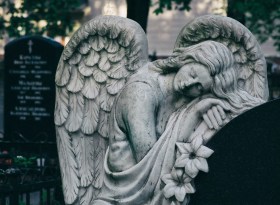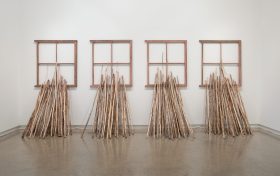The term Anthropocene characterises a period of time in which human activity has led to widespread and lasting impacts on the Earth’s environment. And despite recent conjecture about its actual time frame, what we know without question is that the degree of humanity’s impact on the environment is now being felt with greater urgency.
In the air is a group exhibition that brings together three Indigenous artists (Aidan Hartshorn, Cassie Sullivan and Sabrina Nungarrayi Gibson) and four non-Indigenous artists (Casey Jeffery, Emily Parsons-Lord, Francis Carmody and Xanthe Dobbie) to instigate a dialogue and explore themes such as industry, infrastructure and technology and their impact on Country.
Showing at The Substation, a repurposed power station, now multipurpose arts space in Naarm/Melbourne’s west, the artists interrogate the Anthropocene through a range of mediums such as paint, sculptural pieces, video projections, multimedia and installation works.
Curator, Dr Jessica Clark presents a range of voices in the exhibition with the aim of encouraging the viewer to explore and challenge preconceived notions of ‘Indigenous art’ and the environment. In her essay, Clark suggests, “In the air variously explores critical perspectives on energy and power production, consumption and human impact. Featuring several new commissions alongside recent works, the exhibition equally draws focus to electrical currents and electromagnetic waves circulating within the natural realm, in the earth, in the body, in the air, and beyond.”
Emily Parsons-Lord, who lives and works on the lands of the Boon Wurrung and Wurundjeri Woi Wurrung peoples, distils the undercurrent of the show in her video work A Great Shock of Brilliant Hairs Thrilled the Sky, 2022. Concerned with air and explosions, Parsons-Lord uses the metaphor of combustion to capture the dire state we are now in: remixing and collating eyewitness accounts over centuries, the artist places the viewer in the place of witness to ecological collapse.
Xanthe Dobbie, like Parsons-Lord, lives and works in Wurundjeri Country, Victoria and uses digital media as a form of political protest. The Long Now, 2022 is a kaleidoscope of overlapping and competing internet imagery incorporating ideas of climate grief against techno-capitalism and the notion of immortality as explored through the ancient epic of Gilgamesh. This work is accompanied by an original score by Jorde Heys.
Sorrow for the river i, 2025 (Substation billboard commission) and Sorrow for the river ii, 2025, by Cassie Sullivan, an Indigenous contemporary artist from Lutruwita/Tasmania, explore the polluting of the Queen River in Queenstown. Presented in two parts, a diagrammatic section of the river in Sorrow for the river ii, documents the ecological changes that have occurred due to tailings run-off from the Mount Lyell copper mine – the water now a golden orange due to the oxidised metal content, while on a plinth opposite, an illuminated jar of water detritus glows eerily. The visual beauty of her intricately woven copper wire basket to collect with holes in your basket i, 2024, belies the message of environmental imbalance and devastation to which it alludes.
Along the front of The Substation’s austere façade, five large-scale scanned billboard images glow in the night sky – the colours manipulated to reflect the water testing strips that evaluate pH, alkalinity and acid levels that indicate that the river is no longer able to support life.
Bangadirra, 2024, a sculptural installation made with Wee Jasper Bluestone and neon lighting challenges the value of large-scale engineering projects such as Snowy 2.0 at the expense of the natural environment and significant first nation sights. A work by Indigenous artist Aidan Hartshorn is informed, as a Walgalu and Wiradjuri man, by Country, with traditional lands residing in the High Country of Kosciusko National Park and foothills of Snowy Mountains, as well as the Riverina region of NSW.
In contrast, the colourful acrylic-based paintings of Sabrina Nungarrayi Gibson – an Indigenous artist from the remote Aboriginal community Nyirripi, 400 kilometres north-west of Alice Springs – appear celebratory. Drawing off traditional iconography to represent Lightning Dreaming, the artist uses concentric circles to depict the hock holes found in the area. Half circles represent sand hills while wavy horizontal lines the lightning, which announces the wet season. Her work draws attention to the electrical forces that flow through the land, highlighting the interconnectedness of all things.
Casey Jeffery, an artist on Wurundjeri Country Victoria, also uses paint on canvas, but her focus is to illuminate humanity’s overconsumption of not only goods, but also resources, in her oil and acrylic 2024/25 presents series, while in Naarm/Melbourne artist Francis Carmody’s Continuous Cities – Ferro, 2024, acrylic on canvas screen print piece, hints at the idea of rebirth. It draws from Italo Calvino’s Invisible Cities, a possible dystopian city of the future where new life emerges from the ruins.
Read: RISING 2025 reviews and coverage
Mindfully curated, the exhibition takes the viewer on a journey from the lightness of Sabrina Nungarrayi Gibson’s paintings in the first gallery space to smaller, darker more intimate rooms where the impact of urgency resonates more powerfully. A QR code on entrance, to source futher material, along with text label artist statements and biographs accompany the works. This is an important exhibition that deserves time and reflection.
In the air, curated by Dr Jessica Clark, will be exhibited at The Substation 1 Market Street, Newport, Victoria until 16 August 2025; free entry.


